Turtle Basking: Everything You Need To Know
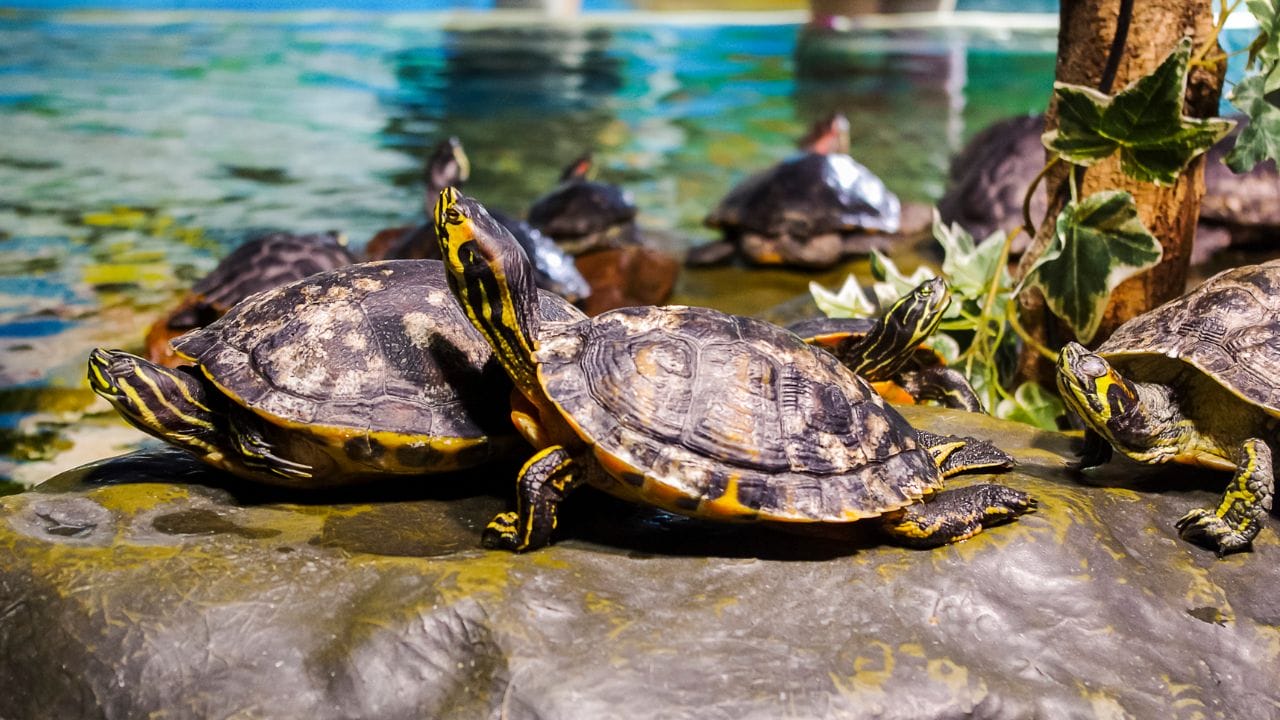
This post was created with help from AI tools and carefully reviewed by a human (Muntaseer Rahman). For more on how we use AI on this site, check out our Editorial Policy.
When I first brought home my turtle, I thought a heat lamp and some lettuce were all it needed. Turns out, I was seriously underestimating the importance of basking.
If you’ve ever caught your turtle stretching out under its light like it’s on vacation, there’s a whole lot more going on than just soaking up rays.
Here’s what I wish I knew sooner about why basking is everything for your turtle’s health.
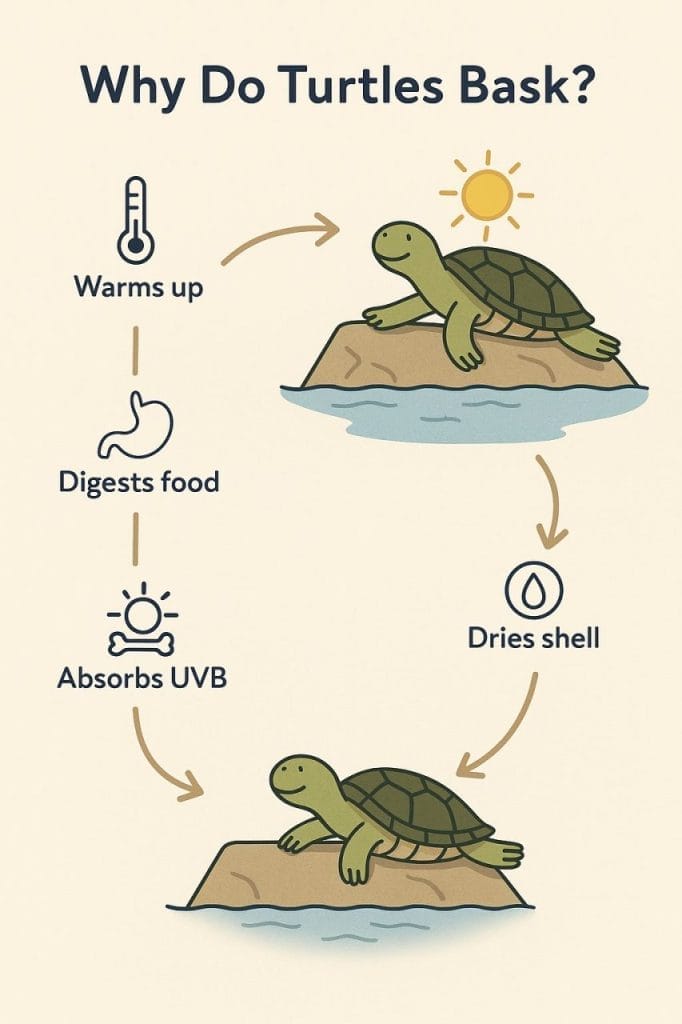
Why Do Turtles Bask?
I’ll never forget the first time I saw my turtle, Sheldon, climb up on his little driftwood and stretch out like he owned the place.
Neck out, legs spread wide, eyes half-closed like he was sunbathing on a tropical beach. At first, I thought, Wow, this guy knows how to relax better than I do!
But basking isn’t just a turtle’s version of chilling. It’s serious business.
Let’s break it down.
| Purpose | Why It Matters |
|---|---|
| Warmth | Keeps their metabolism running |
| Digestion | Helps process food efficiently |
| UVB Absorption | Builds strong bones and shells |
| Shell Drying | Prevents infections and shell rot |
Warm Up the Body
Turtles are cold-blooded. They can’t produce their own heat like we do. So, they soak up warmth from their surroundings.
Basking helps them regulate their body temperature.
Without it, their little systems would slow down like a phone on 1% battery in winter.
Digest Food Properly
Ever tried to digest a big meal when you’re freezing? Neither can turtles.
They need that heat to kick-start their digestion. A warm turtle is a happy turtle with a working gut.
Absorb UVB Rays
Sunlight (or UVB from a lamp) helps turtles make Vitamin D3. That’s the stuff that lets them use calcium to build strong shells and bones.
No basking = no UVB = weak shell.
Nobody wants a floppy turtle.
Dry Out Their Shell
Wet shells all day? That’s a recipe for shell rot.
Basking dries out their bodies, keeping fungal and bacterial infections at bay. Think of it like airing out your gym socks. Necessary.
Turtle Basking: Why, When, How? [Infographic]
If you want a printable version of this PDF, click here. Please link back to this source if you use the infographic on any other website!
This Hilarious Turtle Book Might Know Your Pet Better Than You Do
Let’s be real—most turtle care guides feel like reading a textbook written by a sleep-deprived zookeeper.
This one’s not that.
Told from the snarky point of view of a grumpy, judgmental turtle, 21 Turtle Truths You’ll Never Read in a Care Guide is packed with sarcasm, sass, and surprisingly useful insights.
And hey—you don’t have to commit to the whole thing just yet.
Grab 2 free truths from the ebook and get a taste of what your turtle really thinks about your setup, your food choices, and that weird plastic palm tree.
It’s funny, it’s honest, and if you’ve ever owned a turtle who glares at you like you’re the problem—you’ll feel seen.
How Long Should A Turtle Bask?
When I first got Sheldon, my painted turtle, I would stare at him for hours.
I’d watch him bask for what felt like forever, then suddenly dive back into the water like a kid at a pool party.
But it got me wondering—how long is enough? Could he overdo it? Or worse, not do it enough?
Here’s the scoop.
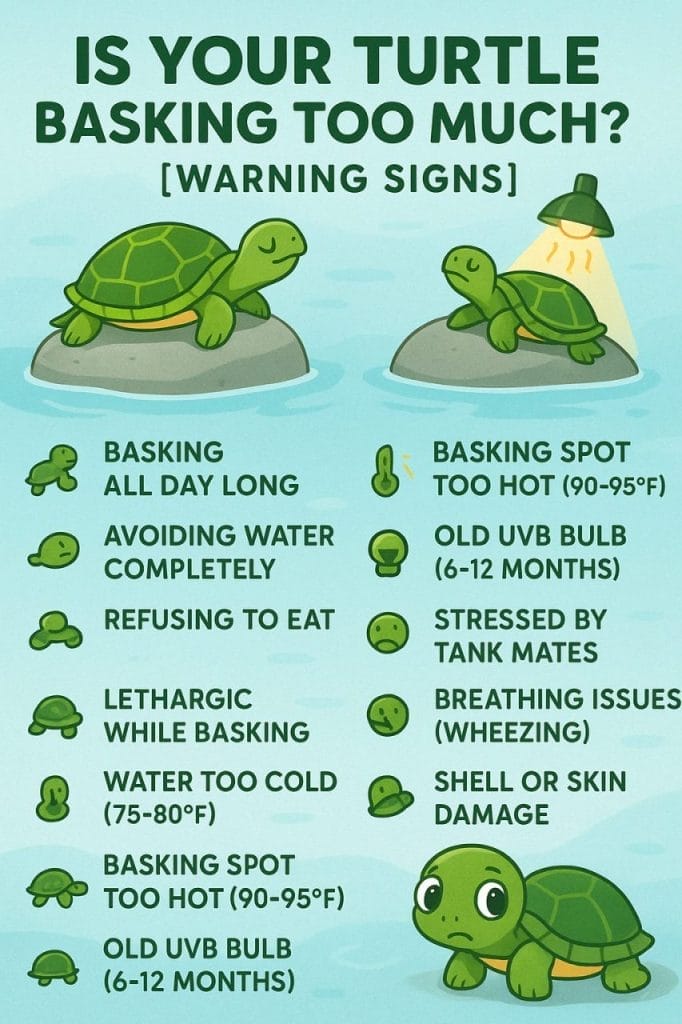
The Magic Basking Window
Most turtles bask between 4 to 8 hours a day. That’s their sweet spot.
But they don’t set a timer. Some days it’s longer, some shorter.
Think of it like your own time on the couch. Some days you binge three episodes, some days just one.
| Turtle Type | Average Basking Time |
|---|---|
| Aquatic (sliders, painteds) | 4-8 hours daily |
| Semi-aquatic (cooters) | 3-6 hours daily |
| Musk turtles | 1-3 hours or barely at all |
| Land turtles (box turtles) | Short bursts, several times a day |
Factors That Change Basking Time:
Species
Different turtles, different vibes. Aquatic turtles like sliders or painteds? They bask a lot.
Musk turtles? Barely care.
Age
Baby turtles tend to bask more. They’re like toddlers—full of energy, always needing a recharge.
Temperature
Cooler water makes turtles bask longer. If your tank’s too cold, they’ll camp out on that platform.
Health
Sick turtles might bask too much. It’s like when you stay in bed all day because you feel off.
Season
Even indoor turtles follow some seasonal instincts. Sometimes they bask less in winter.
A proper basking setup is just one piece of the puzzle. See our full guide on setting up a red-eared slider tank for the complete picture.
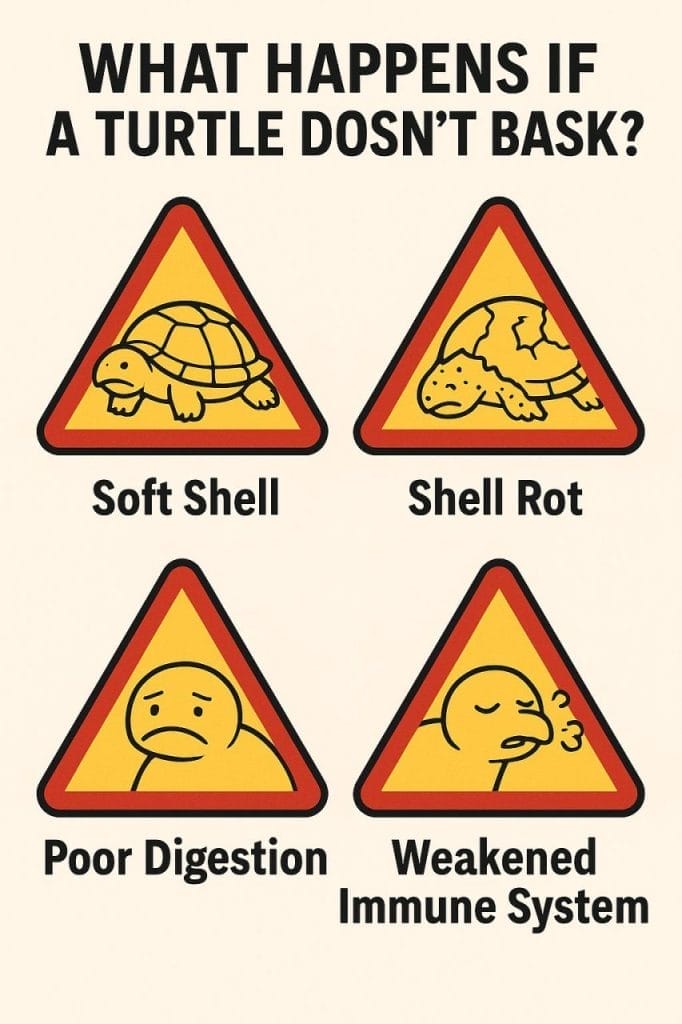
What Happens If a Turtle Doesn’t Bask?
I learned this the hard way with Sheldon. In the early days, he wouldn’t bask much. At first, I thought, Maybe he’s just not feeling it today.
But when he stayed underwater for days without hitting the platform, I knew something was off.
Skipping basking? That’s a big deal.
| Problem | What Happens |
|---|---|
| No UVB exposure | Soft shell, weak bones |
| Shell stays wet | Shell rot infection |
| No heat for digestion | Poor appetite, constipation |
| Weak immune system | More prone to sickness |
| No energy boost | Lethargy, sluggishness |
Shell Problems (Soft Shell or Rot)
Without enough UVB light and heat, turtles can’t process calcium properly. This leads to metabolic bone disease—their shells get soft, bendy, and fragile.
No basking also means their shells stay damp. A wet shell all the time is a recipe for shell rot, which is a nasty infection that eats away at their shell.
Poor Digestion
Turtles need heat to digest their food. No basking = no proper digestion. Food just sits in their bellies, making them uncomfortable.
Imagine eating a huge meal and then sitting in a freezer. Yeah, not pleasant.
Getting the water and basking temperatures exactly right is crucial—one common temperature mistake could be preventing your turtle from basking properly.
Weakened Immune System
Without warmth and UVB, a turtle’s immune system gets weaker. This makes them prone to infections, especially respiratory infections.
Yes, turtles can get colds too. Sneezing, wheezing turtles are a real thing.
Lethargy and Loss of Appetite
When turtles don’t bask, their energy drops. They turn sluggish, stop eating, and barely move.
It’s like when you stay in bed all day and feel drained.
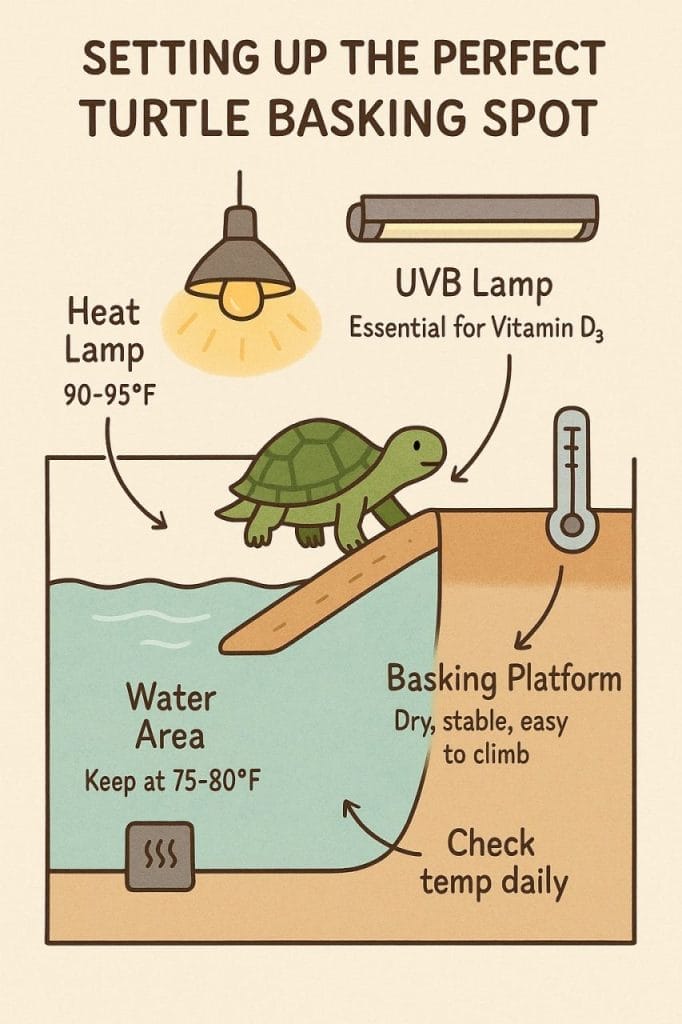
Setting Up the Perfect turtle Basking Spot
Getting your turtle’s basking area right is like setting up a VIP lounge. It needs to be warm, comfy, and safe. Otherwise, your turtle’s gonna give it the cold shoulder.
I’ve been there with Sheldon. The first basking platform I bought? Too small.
He looked at it like, You expect me to use that?
Here’s what I learned about making the perfect basking setup.
| Item | Purpose |
|---|---|
| Basking platform | Dry space for basking |
| Heat lamp | Provides warmth (90-95°F) |
| UVB light | Helps with Vitamin D3 and calcium |
| Thermometer | Monitors basking spot temperature |
The Must-Have Equipment

Basking Platform
Get one that’s big enough for your turtle to fully stretch out. It should be stable and easy to climb. For Sheldon, a floating platform worked, but I had to make sure it stayed steady.

Heat Lamp (Basking Bulb)
This is the sun substitute. Aim for 90-95°F on the platform—check out our complete lighting guide to choose the right bulb and position it correctly.

UVB Light
Essential for making Vitamin D3, which helps process calcium. Without it? Soft shells and weak bones.
Thermometer
Never guess the temperature. I use a digital thermometer to keep things on point.

Common turtle Basking Problems (And Fixes)
Turtles can be picky. Set up everything perfectly, and they’ll still find a reason to snub the basking spot.
Trust me, Sheldon gave me the cold shell treatment more than once.
Here are some common basking problems I ran into—and how I fixed them.
Problem 1: Turtle Not Basking at All
Wrong Temperature
If the basking area isn’t 90-95°F, your turtle won’t bother.Too cold? They’ll stay in the water.
Fix:
Use a good thermometer, adjust the lamp height, or get a stronger bulb.
Poor UVB Light
Turtles know when the UVB is weak or non-existent. No UVB? They might skip basking.
Fix:
Make sure the UVB bulb is less than 6-12 months old. After that, even if it looks fine, it’s probably not doing the job.
Platform Too Small or Slippery
If your turtle can’t fit or keeps sliding off, they’ll avoid it.
Fix:
Get a platform that’s stable and big enough for full body stretching.
Don’t have a traditional tank? You can create an excellent basking setup even in a basic tub.
Stress or Shyness
Turtles get camera shy too. If you’re hovering like I did with Sheldon, they might feel unsafe.
Fix:
Give them space. Step back, let them feel secure.
Problem 2: Turtle Basking Too Much
Water Too Cold
If the water is too chilly, your turtle won’t want to leave the warm basking area.
Fix:
Check your water heater. Keep water temps between 75-80°F for most species.
Sickness
Excessive basking can be a sign of illness, like respiratory infections.
Fix:
If your turtle’s basking all day, seems sluggish, or won’t eat, it’s vet time.
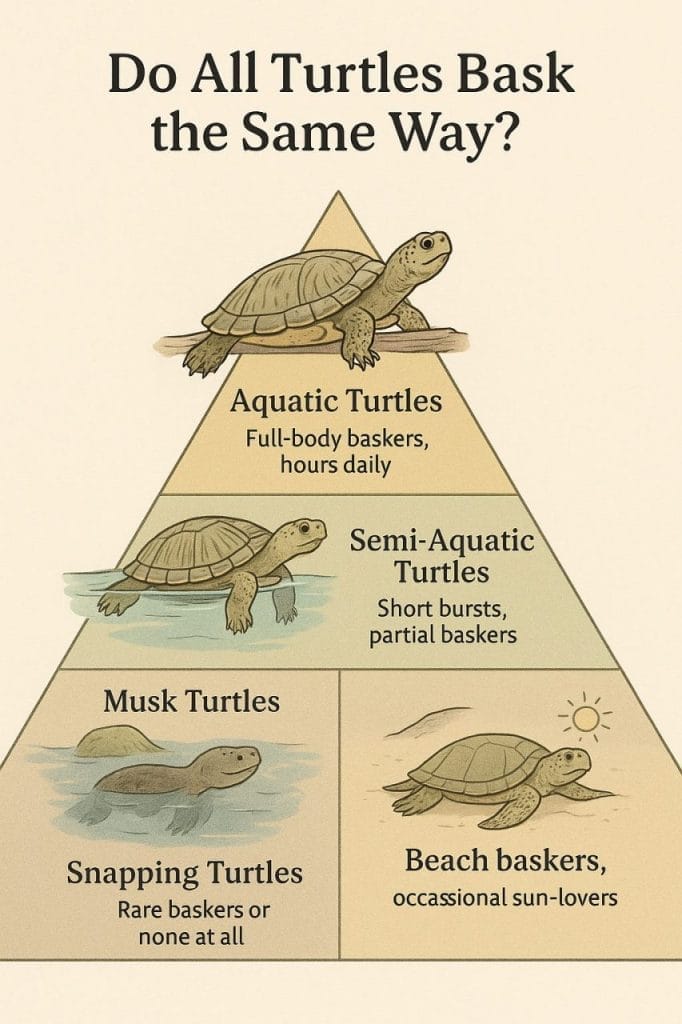
Do All Turtles Bask the Same Way?
Short answer? Nope.
Turtles are like people—different personalities, different routines.
Sheldon, my painted turtle, loves a good stretch. Legs out, head high, looking like he’s practicing yoga. But not every turtle is that extra.
Many popular pet turtles need basking areas to stay healthy. Here’s a simple chart to help you.
| Turtle Species | Needs Basking Area? | Basking Behavior |
|---|---|---|
| Blanding’s Turtle | Yes | Loves basking; often seen on logs and rocks |
| Bog Turtle | Yes | Basks often in shallow sunny spots |
| Box Turtle | Yes | Needs dry land for basking |
| Chicken Turtle | Yes | Basks daily; quick to dive when disturbed |
| Cooter Turtle | Yes | Heavy basker; spends long hours sunning |
| Map Turtle | Yes | Basks in groups; shy around movement |
| Mata Mata Turtle | Optional | Almost never basks; prefers staying underwater |
| Mud Turtle | Optional | Rare basker; mostly hides underwater |
| Musk Turtle | Optional | Very rare basker; floats near the surface |
| Painted Turtle | Yes | Big fan of basking on rocks or logs |
| Red Eared Slider | Yes | Basks daily; often stacks with others |
| Sea Turtle | No (in captivity) | Wild ones float near surface to warm; no basking area needed in captivity |
| Snapping Turtle | Optional | Rare basker; warms up by floating when needed |
| Softshell Turtle | Yes | Basks on sandy banks or flat rocks when feeling safe |
| Spotted Turtle | Yes | Daily basker; enjoys sunny calm spots |
Species marked as optional may still enjoy basking if they feel safe. Providing a basking spot is always a good idea, even for rare baskers.
Aquatic Turtles
Examples: Red-eared sliders, painted turtles, cooters
These guys are basking pros. They climb out of the water, dry off completely, and soak up heat and UVB for hours.
Aquatic turtles need strong basking setups because they rely on that heat to stay healthy.
Semi-Aquatic Turtles
Examples: Box turtles, some mud turtles
They bask too, but not always the full-body sunbathing style. Some prefer to stay half in, half out of the water.
Box turtles? They may bask on land, but usually in short bursts.
Musk and Snapping Turtles
Musk turtles are the rebels. They rarely bask or only do it partially, like poking their heads out of the water.
Snapping turtles? Almost never bask. These guys just don’t care.
I remember when I first looked up basking habits for musk turtles. I thought, Are they broken? But nope—they’re just not into it.
Sea Turtles
Sea turtles bask too, but they take it up a notch. Some species (like green sea turtles) haul themselves onto beaches to bask in the sun.
It’s like a full-blown beach vacation.
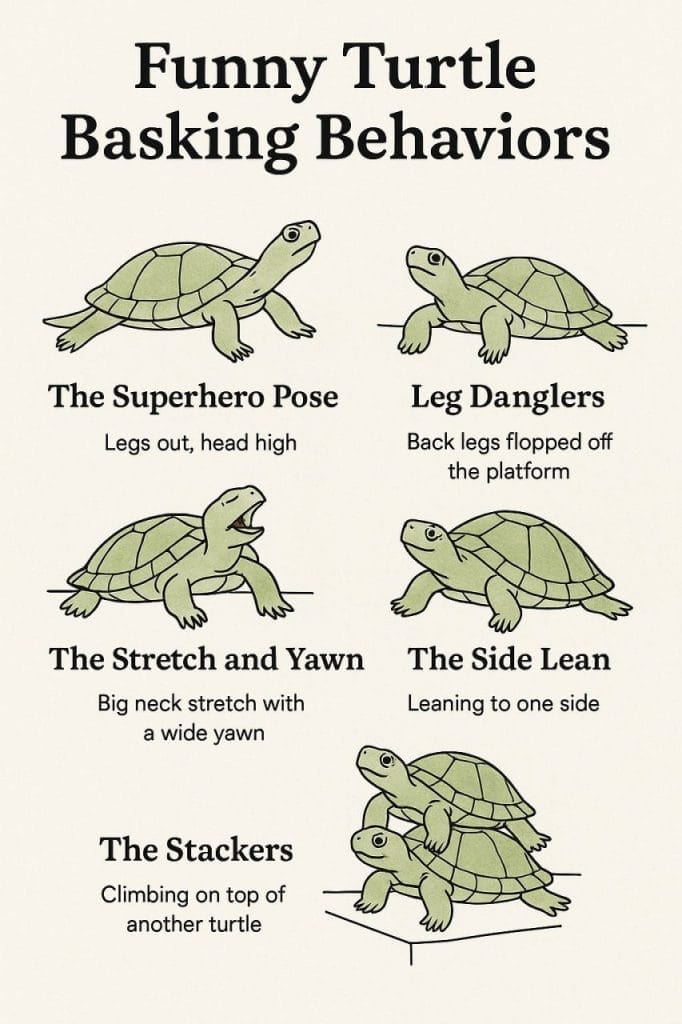
Funny Turtle Basking Behaviors
Basking isn’t just a health thing for turtles—it’s a whole performance. Once Sheldon gets up on his platform, it’s like watching a tiny reptile fashion show.
| Behavior | What It Looks Like |
|---|---|
| Superhero pose | Legs out, head high, total confidence |
| Leg danglers | Back legs flopped off the platform |
| Stretch and yawn | Big neck stretch with a wide yawn |
| Side lean | Leaning like posing for a camera |
| Stacking | Climbing on top of another turtle |
The Superhero Pose
This is my favorite. Front legs stretched out, head raised like he’s about to take flight. Sometimes, I imagine he’s thinking, I am Turtleman!
The Leg Danglers
Some turtles let their back legs dangle off the platform. Just flopped there like they couldn’t care less. Sheldon does this when he’s feeling extra lazy.
The Stretch and Yawn
Oh, the yawn-stretch combo—a true classic. It’s that big, slow neck stretch followed by an open-mouth yawn. Every time I see it, I swear he looks like he’s saying, Rough day, huh?
The Side Lean
Some turtles lean to one side when basking. I caught Sheldon once, half-leaning like he was posing for a magazine shoot. If he had sunglasses, it would’ve been perfect.
The Stackers
If you’ve got more than one turtle, stacking happens. One turtle climbs right on top of the other to get the best basking spot. No personal space rules in the turtle world.

About Author
Muntaseer Rahman started keeping pet turtles back in 2013. He also owns the largest Turtle & Tortoise Facebook community in Bangladesh. These days he is mostly active on Facebook.












